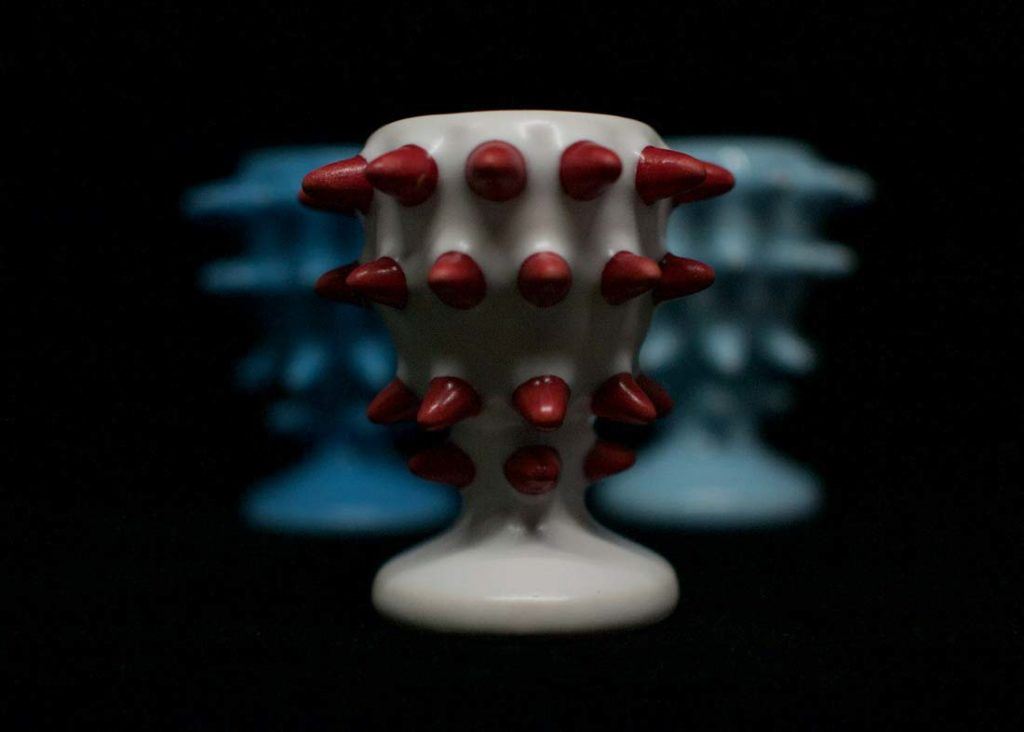![The Spike Cup, 3D printed in ceramic and with protrustions colored blood red with a white cup, done in a matte glaze [Image: Joy Complex]](https://fabbaloo.com/wp-content/uploads/2020/05/Cups-02-1024x7321_img_5eb0998343a57.jpg)
We know ceramic 3D printing is around, but that doesn’t mean it’s easy to find.
Ceramic 3D printing — thinking particularly about pottery-style designs, rather than high-value ceramics for aerospace and other industrial applications — offers some interesting capabilities for designers.
Certainly the process is involved, requiring more post-processing than traditional FFF 3D printing with plastic, as ceramic pieces have to be dried, fired in a kiln, glazed, fired again, and finished to suit, all of which are relatively hands-on and time-consuming.
So outsourcing to a service bureau makes a great deal of sense, especially for those who don’t work with ceramics at high enough volumes to justify investing in all the equipment required.
But where would someone actually go to get a ceramic 3D print made?
Several major service bureaus have removed ceramics from their 3D printing offerings.
Notably, Shapeways and i.materialise eliminated the offerings. Shapeways, it turns out, had quite a long history with ceramic materials: in looking into this material, I fell into a bit of a rabbit hole of Shapeways’ blog posts and material updates, which included introductions, price reductions, price increases, reviews of the hands-on work required, a switch from Ceramic to Porcelain, and, finally, elimination altogether. Quite the odyssey — and one leaving designers lacking in options.
Joy Complex’s Jeremy Burnich recently fell into his own rabbit hole exploring all this. His journey, though, was not theoretical: he needed to find a way to 3D print with ceramics.
In an intriguing travelogue of his experiences, Burnich recounts his experiences in seeking out viable, accessible ceramic 3D printing today. While acknowledging that “ceramic wasn’t a big profit center” for Shapeways or i.materialise, he noted:
“There is definite interest in additive ceramic though. Smaller players like Tethon 3D and Formlabs have a ceramic resin product and designers have been able to create some amazing things using it.”
Several options are indeed on the market. But going back to viability, Burnich continues into the difficulties of ceramic 3D printing, noting that it “is not something the average apartment dweller will be able to do at home.”
When a customer approached Burnich inquiring about a spike cup he had made, he sought new options as the previous solution with Shapeways’ Porcelain was no longer available. It was in this search that his “internet sleuthing” brought him over to Kwambio.
Burnich’s journey in ceramic 3D printing today is indeed a tale of his experience working with Kwambio’s service.
It’s an interesting report, and worth the read for personal experience and detail in working with the company — and some interesting thoughts on business in today’s global society. Once pricing on the cups worked out, “shipping was the bottleneck” as getting the finished pieces “through Europe, over the Atlantic, and over to Pittsburgh” was necessarily going to cost a good deal of money (via UPS) or time (via Ukrposhta). Opting for the latter, it seems the pieces were worth the wait.
A side-by-side comparison with some of the original Shapeways-made cups was generally rather favorable. Each piece was sized slightly differently, with less-spiky spikes: “but they were good enough for what they needed to be.”
![Left: Shapeways Porcelain; right: Kwambio Ceramic [Image: Joy Complex]](https://fabbaloo.com/wp-content/uploads/2020/05/Cups-01-1024x7321_img_5eb0998384dfa.jpg)
Burnich experimented with several of Kwambio’s offerings, including different coloring and glazes. All in all, the experience was positive:
“For an artist or designer that really gets comfortable using Kwambio for production of their work, they offer tiered pricing for larger runs of a single design. If they can nail shipping or offer direct to client shipping, then Kwambio’s future looks bright.”
Kwambio offers both ceramic 3D printers and a 3D printing service. It’s nice to hear a trusted designer vouch for the service, and that speaks highly enough for me to say that anyone interested in ceramic 3D printing might indeed do well to look into Kwambio’s options.
Via Joy Complex











Tritone has been quietly building their MoldJet technology and is nearing a release of their beta 3D printing equipment.